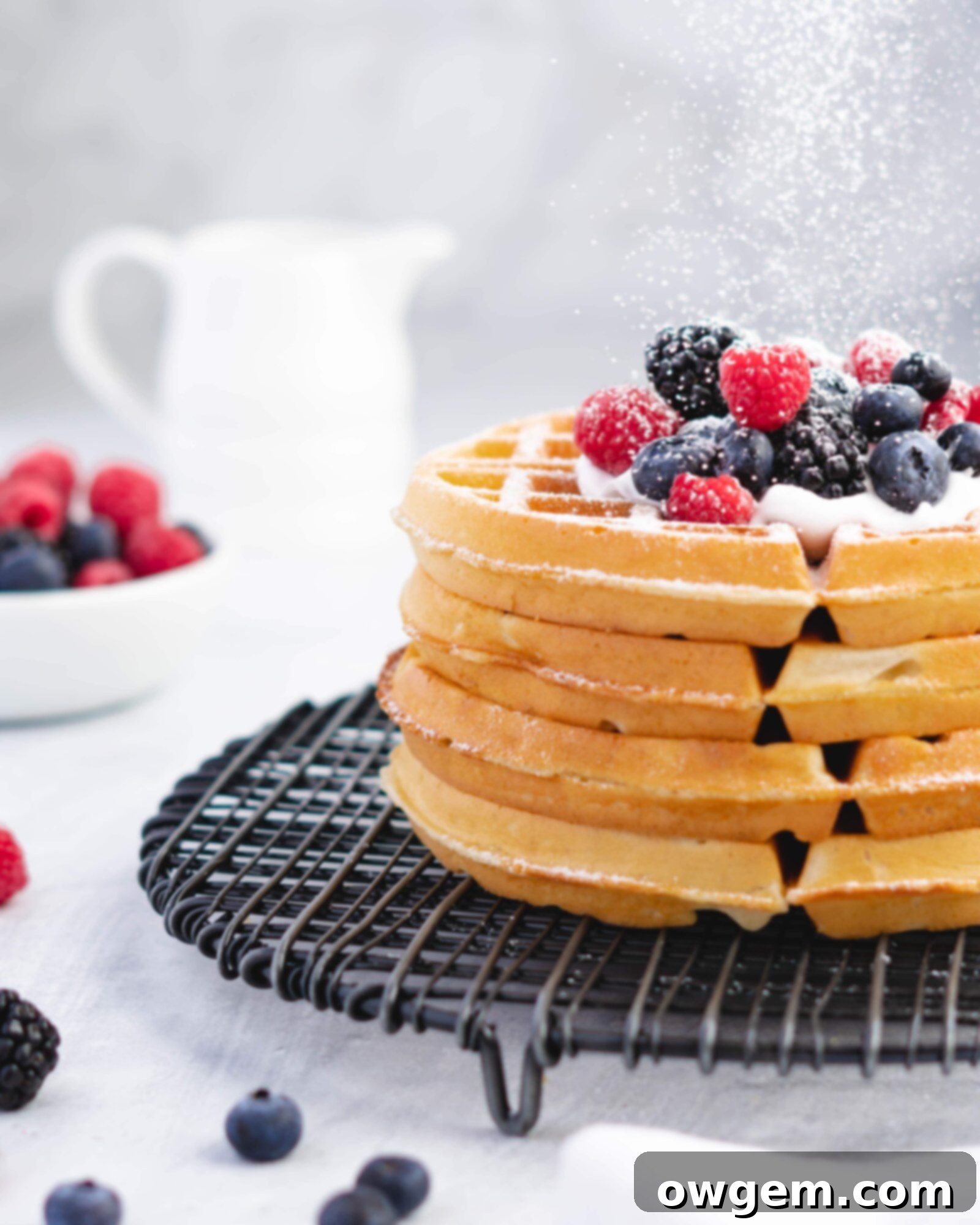Achieve Waffle Perfection: The Ultimate Recipe for Fluffy & Crispy Buttermilk Belgian Waffles with Maple Syrup
Imagine waking up to the irresistible aroma of freshly made waffles, perfectly golden brown and beckoning you to the breakfast table. These Buttermilk Belgian Waffles, generously infused with rich maple syrup, promise an unparalleled culinary experience that truly elevates your morning. Every bite delivers a delightful contrast: a wonderfully crisp exterior that yields to a pillowy soft, airy interior. This heavenly texture is not by chance; it’s the result of carefully incorporating delicately whipped egg whites, stabilized into a French meringue with a touch of sugar, which is then gently folded into the batter. Prepare to discover the secret to waffle perfection that will make every breakfast feel like a special occasion.
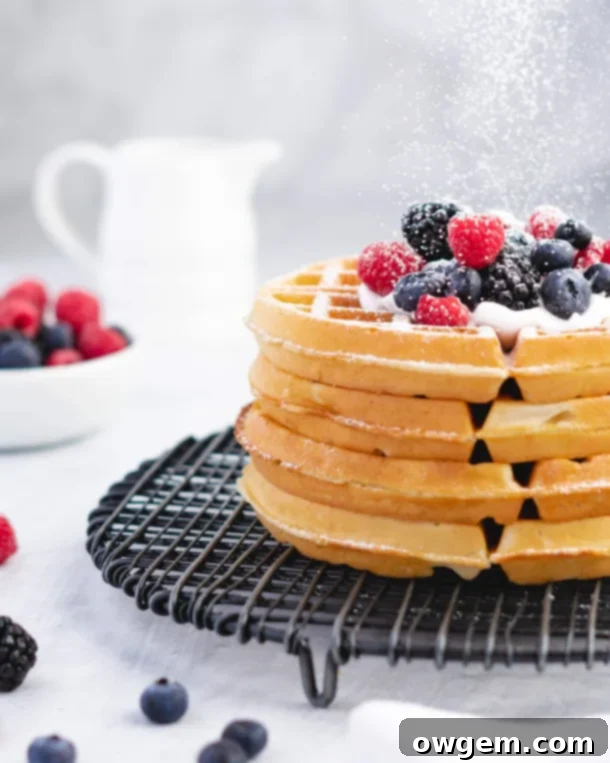
The Perfect Combination of Fluffy and Crispy
For many, the ideal waffle strikes a delicate balance between being wonderfully fluffy on the inside and irresistibly crispy on the outside. This dual texture is the hallmark of a truly exceptional waffle. The interior should be light, airy, and tender, almost melting in your mouth, while the exterior should boast a beautiful golden-brown hue and a satisfying crunch with every bite. Our Buttermilk Belgian Waffles achieve precisely this coveted combination. The secret lies in a few key techniques and ingredients that work in harmony to create this textural masterpiece.
By meticulously folding in egg whites that have been stabilized into a meringue with sugar, we introduce an incredible amount of air into the batter, leading to an unparalleled fluffiness that sets these waffles apart. Furthermore, incorporating maple syrup directly into the batter offers three distinct advantages:
- Enhanced Flavor Depth: The maple syrup adds a rich, nuanced sweetness and a complex flavor profile that beautifully complements the buttermilk, elevating the overall taste of the waffle.
- Superior Caramelization: The natural sugars in the maple syrup aid in the caramelization process during cooking, contributing to that desirable deep golden-brown color and robust crispiness on the waffle’s surface.
- Optimal Batter Consistency: Maple syrup helps to keep the batter just thin enough to spread evenly in the waffle iron, allowing for maximum contact with the hot plates, which is crucial for achieving that wonderfully crisp exterior without making the interior dense.
Together, these elements ensure each waffle delivers on the promise of both a light, airy texture and a satisfyingly crisp bite, making every breakfast a delightful experience.

The Secret to Unbeatable Fluffiness: Stabilized Egg Whites
Belgian waffle recipes, much like other culinary classics, come in a myriad of variations. However, when it comes to achieving ultimate fluffiness, I prefer to categorize them into two main types: those that use whole eggs and those that utilize separated eggs. Through extensive experimentation, I’ve unequivocally concluded that recipes calling for separated eggs are vastly superior. The technique of folding in whipped egg whites provides an unrivaled method for imparting an incredibly airy and fluffy texture to Belgian waffles.
While plain whipped egg whites are incredibly delicate and prone to losing their volume quickly, I’ve discovered a game-changing technique: stabilizing the egg whites with sugar to form a French meringue. This simple addition creates much more stable egg whites that retain their air and volume far more effectively. The sugar molecules bind to the egg white proteins, strengthening their structure and preventing them from collapsing easily. This stability means you can be a little less delicate when folding the meringue into the rest of the batter, without fear of losing that precious volume. The result is consistently light, airy, and beautifully fluffy waffles every single time.
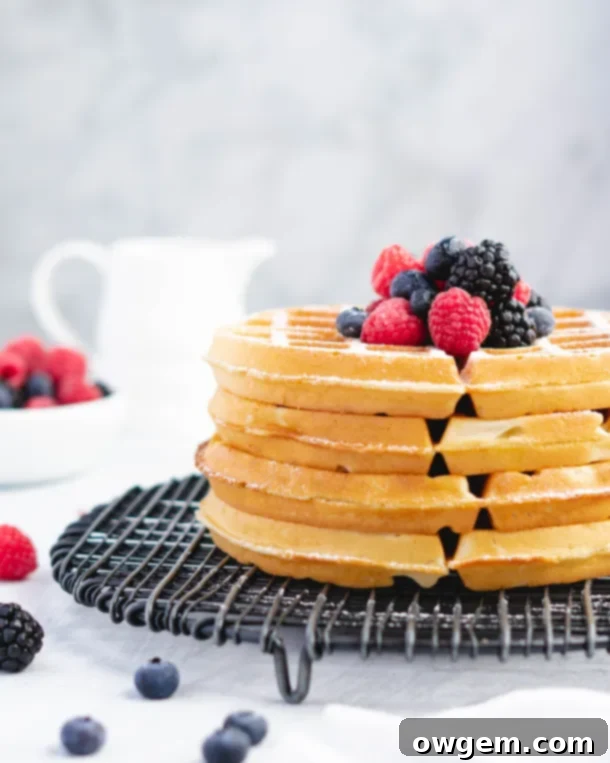
Mastering Meringue: Tips for Room Temperature Egg Whites
Just like with any recipe that calls for whipping egg whites, ensuring your eggs are at room temperature is a crucial step for success. The reason is purely scientific: room temperature egg whites have a lower surface tension compared to cold egg whites. This means their proteins are more relaxed and elastic, allowing them to stretch and incorporate air much more easily and efficiently when whipped. Cold egg whites are denser and more resistant to aeration, resulting in a longer whipping time and often a less voluminous, less stable meringue.
If you’ve forgotten to take your eggs out in advance, don’t worry! There’s a quick trick to bring them to room temperature. Simply fill a glass or a small bowl with hot tap water (not boiling) and carefully place the cold eggs into the water. Let them sit for about 5 to 10 minutes. This gentle warming process will quickly bring them up to the ideal temperature for whipping, ensuring you get those beautiful, voluminous peaks every time.
Crafting the Perfect Meringue
Creating a flawless French meringue for your waffles is surprisingly straightforward, yet it requires a bit of attention to detail. Begin by whipping your room temperature egg whites in a clean, dry bowl (preferably a stand mixer with a whisk attachment or a hand mixer) until they reach stiff peaks. This means that when you lift the whisk, the peaks stand tall and hold their shape firmly, without drooping. At this stage, your egg whites are full of air and ready for the sugar.
Once stiff peaks are achieved, it’s time to introduce the sugar. This is where patience is key: sprinkle the sugar in *slowly* and gradually, continuing to beat the egg whites as you do so. Adding the sugar slowly allows it to dissolve evenly into the egg whites, preventing a grainy texture and ensuring a smooth, stable meringue. Continue to beat until the peaks are not only stiff but also beautifully glossy, with a smooth, almost satiny texture throughout. If you notice any slight graininess, simply continue whipping for a minute or two longer until the sugar has completely dissolved and the meringue is perfectly smooth and brilliant. This stable, airy meringue is what will give your Belgian waffles their signature light and fluffy interior.
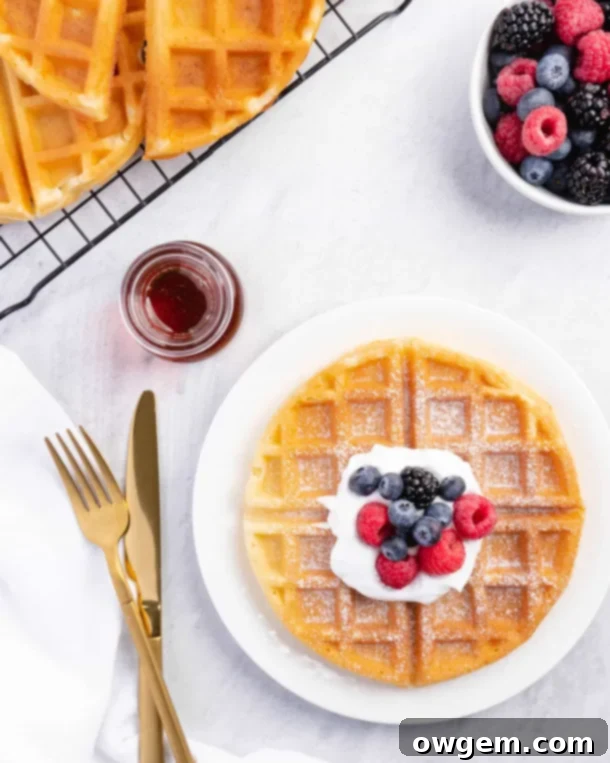
The Art of Batter Management: Resting for Optimal Texture
While our meringue technique significantly contributes to the fluffiness of these waffles, proper batter handling is equally important. Even with stabilized egg whites, it’s crucial not to overmix the batter once the meringue is incorporated. Overmixing can still lead to deflating the meringue, thereby losing the precious air we’ve worked so hard to incorporate. More importantly, overworking the gluten in the flour can result in tough, chewy waffles – a texture nobody desires!
Beyond careful mixing, I’ve found that allowing the batter to rest for an optimal period is a game-changer for achieving maximum fluffiness and tenderness. A resting period of 15 to 30 minutes allows two critical processes to occur:
- Gluten Relaxation: The gluten strands, which become tense during mixing, are given time to “relax.” This relaxation prevents the waffles from becoming dense or rubbery, contributing to a wonderfully tender crumb.
- Starch Hydration: The flour and cornstarch in the batter get an opportunity to fully soak up all the liquids. This hydration causes the starch molecules to swell and expand. When these fully hydrated starch molecules cook, they create a softer, more pillowy texture, leading to an even fluffier waffle.
This resting step is a simple yet powerful technique that significantly enhances the final texture of your Belgian waffles, making them truly irresistible.
Why Buttermilk Makes All the Difference
Buttermilk is not just a name in this recipe; it’s a cornerstone ingredient that plays a vital role in both the flavor and texture of these exceptional Belgian waffles. Its tangy, slightly acidic profile adds a delightful depth to the overall taste, cutting through the sweetness of the maple syrup and creating a more complex, well-rounded flavor. Beyond taste, buttermilk’s acidity interacts beautifully with the baking powder, producing carbon dioxide gas which contributes significantly to the batter’s lift and airiness. This chemical reaction helps to make the waffles light and fluffy, working in conjunction with our meringue technique.
Furthermore, buttermilk tenderizes the gluten in the flour, preventing the waffles from becoming tough even if the batter is mixed a little more than ideal. Its slightly thicker consistency also ensures the batter is rich enough to produce a substantial yet tender waffle. For the best results, always opt for full-fat buttermilk, as indicated in the recipe notes. Lower-fat varieties can make the batter too thin, potentially compromising the desired fluffy interior and crispy exterior. If you don’t have buttermilk on hand, you can make a substitute by adding one tablespoon of white vinegar or lemon juice to a measuring cup, then filling the rest with regular milk (preferably whole milk) to the desired amount and letting it sit for 5-10 minutes until it slightly curdles.
Your Guide to Waffle Iron Success
The waffle iron itself is a key player in achieving waffle perfection. While any waffle iron will work, a Belgian waffle iron, with its deeper grids, is ideal for creating those characteristic thick, airy waffles with plenty of pockets for syrup and toppings. Here are some tips for maximizing your waffle iron’s performance:
- Preheat Thoroughly: Always ensure your waffle iron is fully preheated before pouring in the batter. Most modern waffle irons have an indicator light that signals when it’s ready. A hot iron ensures instant crisping and prevents sticking.
- Grease Properly: Even non-stick waffle irons benefit from a light greasing before the first waffle, and sometimes between subsequent waffles. Use a neutral oil or cooking spray. This prevents sticking and promotes that beautiful golden-brown crust.
- Don’t Overfill: Resist the urge to pour too much batter. Overfilling can cause batter to spill out the sides and make it difficult to achieve even cooking. Start with a smaller amount and adjust as needed for your specific waffle iron.
- Be Patient: Allow the waffles to cook completely. Resist opening the iron too early, as this can interrupt the cooking process and lead to unevenly cooked or dense waffles. Wait for the steam to significantly diminish and the indicator light to signal readiness, usually around 4-5 minutes on a medium setting.
- Golden & Easy Release: Your waffles are ready when they are golden brown and easily pull away from the cooking plates without resistance.
Serving Suggestions to Elevate Your Waffles
Once your fluffy and crispy Buttermilk Belgian Waffles are hot off the iron, the real fun begins: toppings! While a drizzle of pure maple syrup is a classic and always delicious choice, don’t limit yourself. Here are some ideas to turn your waffle breakfast into an extraordinary feast:
- Classic & Simple: A dusting of powdered sugar and fresh berries (strawberries, blueberries, raspberries) for a light and refreshing option.
- Creamy Indulgence: A dollop of whipped cream or a scoop of vanilla ice cream, especially delicious with a warm fruit compote (berry, cherry, or apple).
- Nutty Crunch: Chopped nuts (pecans, walnuts, almonds) or a drizzle of almond or peanut butter for added protein and texture.
- Decadent Delights: Chocolate chips, chocolate sauce, or a caramel drizzle for those with a sweet tooth.
- Savory Twist: For a unique brunch, serve alongside crispy bacon, fried chicken, or a fried egg, topped with a little hot sauce or savory gravy.
- Seasonal Specials: During the fall, try a pumpkin spice whipped cream or apple slices sautéed in cinnamon. In summer, fresh peaches or grilled pineapple slices are fantastic.
No matter your preference, these versatile Buttermilk Belgian Waffles provide the perfect canvas for your culinary creativity. Enjoy experimenting with different combinations!
Troubleshooting & Expert Tips for Perfect Waffles
Even with a great recipe, sometimes things can go awry. Here are some common issues and how to fix them, along with extra tips for success:
- Waffles are Sticking: Ensure your waffle iron is fully preheated and adequately greased. If using a new iron, sometimes seasoning it according to manufacturer instructions helps. If they continue to stick, try adding a little more oil to your batter next time.
- Waffles are Not Crispy: This often happens if the waffle iron isn’t hot enough, or if the batter is too thin (e.g., using low-fat buttermilk). Make sure you’re not overfilling, as too much batter can prevent even crisping. The maple syrup in this recipe helps with caramelization, so ensure you’re using the correct amount.
- Waffles are Too Dense: Overmixing the batter (deflating the meringue or overworking gluten) is the most common culprit. Be gentle when folding in the meringue. Also, ensure your baking powder is fresh and active. The resting period is crucial for a tender crumb.
- Uneven Browning: Make sure your waffle iron is heating evenly. Some older models might have hot spots. Also, ensure you’re distributing the batter evenly across the plates.
- Make Ahead & Storage: Cooked waffles can be kept warm in a low oven (around 200°F / 95°C) on a wire rack while you finish the batch. For longer storage, allow them to cool completely, then freeze them in a single layer on a baking sheet before transferring to a freezer-safe bag. Reheat in a toaster, toaster oven, or even the waffle iron for a few minutes until crispy again.
By paying attention to these details, you’ll consistently achieve restaurant-quality Buttermilk Belgian Waffles right in your own kitchen.
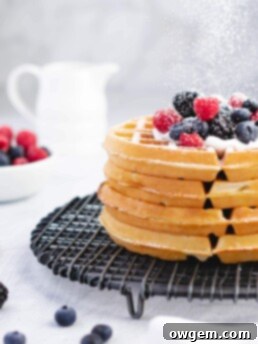
Get the Recipe:
Buttermilk Belgian Waffles
Pin
Rate
Ingredients
- 1 3/4 cup All-Purpose Flour
- 1/4 cup Corn Starch
- 4 tsp Baking Powder
- 1/2 tsp Salt
- 2 cups Buttermilk, 3.25%
- 1/2 cup Vegetable Oil
- 1/4 cup Maple Syrup
- 2 Eggs, separated,, at room temperature
- 1/4 cup Sugar
Instructions
-
In a large bowl, sift together the all-purpose flour, corn starch, baking powder, and salt. In a separate medium-sized bowl, whisk together the buttermilk, vegetable oil, maple syrup, and egg yolks until well combined.
-
Pour the wet ingredients mixture into the dry ingredients and mix gently until just smooth. Be careful not to overmix; a few small lumps are acceptable.
-
Meanwhile, in a very clean, separate bowl, beat the room temperature egg whites using a stand mixer with a whisk attachment or a hand mixer, until stiff peaks form. Once stiff peaks are achieved, slowly and gradually sprinkle the sugar into the egg whites while continuing to beat. Continue to beat until a silky, glossy French meringue has formed. The meringue should be stiff, smooth in texture, and hold its shape beautifully. If you detect any slight graininess, continue beating until the sugar is fully dissolved and the meringue is smooth.
-
Gently add about 1/3 of the prepared meringue into the waffle batter and mix lightly to loosen and lighten the batter. Then, carefully fold in the remaining 2/3 of the meringue into the batter using a spatula, being particularly careful not to overmix or deflate the airy meringue. Your goal is to combine it gently while retaining as much volume as possible.
-
(Optional but Recommended): Allow the waffle batter to rest for 15 to 30 minutes at room temperature. This resting period allows the gluten to relax, resulting in a more tender waffle, and gives the starch molecules in the flour time to fully hydrate, contributing to an even fluffier texture.
-
Preheat your waffle iron according to the manufacturer’s instructions. Once hot, lightly grease the cooking plates (even if non-stick). Pour the waffle batter into the center of the preheated and greased waffle iron, spreading it gently if needed, but do not overfill. Cook on a medium setting for approximately 4-5 minutes, or until your waffle light indicates it’s done and the waffles are beautifully golden brown and crispy. When ready, the waffles should easily pull away from the cooking plates. Serve immediately with your favorite toppings and enjoy your perfectly fluffy and crispy Buttermilk Belgian Waffles!
Notes
